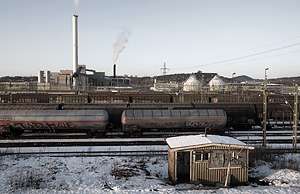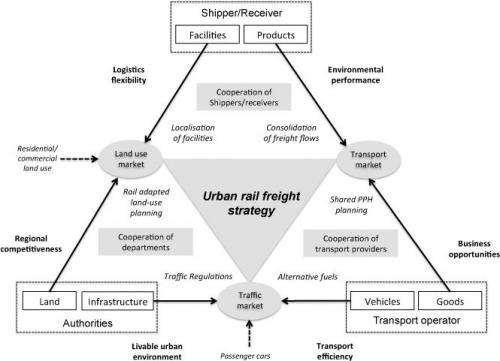Increased amount of rail freight requires cities to change

Rail freight terminals are generally centrally located in cities. In order to achieve a sustainable transport system, where most freight is transported by rail rather than by lorry, terminals must be relocated to urban peripheries. This is a conclusion of Sonke Behrends' doctoral thesis. The thesis investigates how urban and long-distance freight impact one another.
When switching to a sustainable transport system, one key factor involves shifting more freight transport from road to rail. This change, however, can result in increased environmental problems in the local urban environment – primarily due to transshipment from train to lorry, that must almost always take place in order to transport the freight the last mile.
For historical reasons, intermodal freight terminals are generally located in close vicinity to the passenger train station. An increased level of rail freight leads to more local air pollution, noise and congestion at these central locations. If, on the other hand, freight is transported by road the entire distance, the negative effects inside cities may diminish, for instance because many lorries do not need to enter the urban core.
So the question is: how can this dilemma of global sustainability versus local sustainability be resolved? Sönke Behrends investigated the issue in his thesis at Chalmers University of Technology.
"Local politicians and authorities must take rail freight more into account when planning cities; in part to create a better city for residents, and in part to increase the competitiveness of rail, which is currently limited by freight terminals that are difficult to access and that have a low degree of efficiency during transshipment to lorry," he says.

In practice, this means that freight terminals must be moved to urban peripheries. These areas offer freight terminals the space and infrastructure needed to produce effective transshipments, and at the same time the impact on the local environment would be reduced and moved to a location where less people are affected.
The same applies to most major European cities. Some examples include Stockholm, Gothenburg and Hannover. Some cities such as Gothenburg and Hannover already have long-term plans to move their freight terminal out of the urban core. However, there are generally several obstacles to implementing such a move – for example, the cost of new infrastructure and local protests at the planned location of the new terminal.
In addition to relocating freight terminals, several other things also need to be done to achieve livable urban environments that also offer effective freight transports. Sönke Behrends says that the main problem is related to a lack of resources and knowledge on the part of local decision-makers.
"Urban planners often lack the required logistics expertise and holistic view," he says. "They perceive the economic interests as separate from the social and environmental interests, and they lack a long-term strategy for balancing the different interests."
As part of his thesis, he developed a framework to help urban planners make decisions that lead to sustainable transport systems (see image above). The framework aims to clarify the complex web of societal interests that are impacted by local decisions. It also illustrates the advantages that rail-adapted planning can offer a city, which might encourage cities to include rail freight in their strategies for achieving sustainable development, rather than forcing them to do it.
"In addition to reducing the environmental impact and congestion, rail-adapted urban planning can improve a city's accessibility to the national and European transport system," says Sönke Behrends. "This is important for the city's economic development, since accessibility to sustainable transport will become increasingly important in the future."
More information: Read the doctoral thesis Urban freight transport sustainability - the interaction of urban freight and intermodal transport
Provided by Chalmer's University of Technology
















